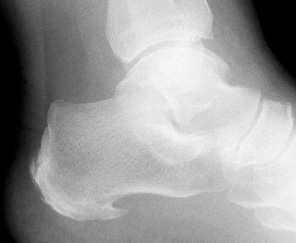DELRAY BEACH, Fla. — If you are experiencing extreme pain in your rearfoot, especially while standing or walking, it might be time to look into heel spur surgery.
A heel spur, also known as a calcaneal spur, develops as an abnormal growth of the heel bone when calcium deposits form a bony protrusion on the underside of the heel — a process that usually occurs over a period of many months.
These spurs are especially common among athletes whose activities include large amounts of running and jumping. Additionally, women have a significantly greater risk for heel spurs due to their typically constraining choices in footwear.
The pain caused by heel spurs is often worst when you first arise in the morning and get to your feet. You may also experience intermittent or chronic pain during physical activates such as walking, jogging, or running if inflammation develops at the point of the spur formation.
In most cases, the pain caused by heel spurs can be resolved with a combination of icing, rest, foot stretches and supporting the foot with an orthotic shoe insert specifically designed by a podiatrist for this condition. In some cases, an injection with a corticosteroid may be done to relieve inflammation in the area.
However, if conservative treatment fails to treat symptoms of heel spurs after a period of 9 to 12 months, surgery may be necessary to relieve pain and restore mobility.
At Delray Beach Podiatry, Dr. Ian S. Goldbaum, a podiatric physician and surgeon with over 30 years of experience, has the ability to treat patients suffering from for heel spurs in a variety of different surgical procedures.
Heel Spur Surgery
Treating foot pain with heel spur surgery can be done in a couple different ways, the most common being an endoscopic plantar fasciotomy. In this procedure two slits are made around the heel in order to detach or cut the plantar fascia ligament from the heel bone in order to relieve pain and allow new fascia tissue to develop in the space that was created. With this procedure, the tension that created plantar fasciitis or heel spurs is eliminated.
“There are several types of procedures that can be done,” said Dr. Goldbaum, who has offices in Delray Beach and Boynton Beach. “One is what they call a medial approach onto the side of the foot while others can go directly through the bottom of the foot. The biggest thing, however, isn’t spur itself, but rather the detachment of the plantar fascia.”
In the vast majority of cases, Dr. Goldbaum notes, heel spurs are often accompanied by plantar fasciitis, a painful inflammation of the fibrous band of connective tissue that runs along the bottom of the foot and connects the heel bone to the ball of the foot.
“When you detach the plantar fascia from that area, a lot of people leave their spurs in, which is typically a judgment call by the doctor,” said Dr. Goldbaum. “I remove some of the spur, but don’t usually take off the entire spur off. You don’t detach the whole plantar fascia, but only the part that’s pulling.”
In order to give his patients the most complete care possible, Dr. Goldbaum also runs a simple test in order to determine the tightness of the gastrocnemius, which is a very powerful muscle that is in the back part of the lower leg. If the foot is unable to bend beyond a certain degree, there is likely a problem with the gastrocnemius contributing to the heel pain that can also be corrected during the spur-removal procedure.
At Delray Beach Podiatry, heel spur surgery is performed a nearby surgical center, takes roughly an hour to complete and requires only three stitches. Following surgery, patients are placed into a walking boot for 14-21 days and typically return for a follow-up appointment within 3-to-4 days after the procedure. Once the stitches have been removed, patients will be presented with several options in order to protect themselves from future painful procedures. These options include: custom-made orthic shoe inserts, cold laser treatments to reduce inflammation, and physical therapy.
“If you do the conservative approach while also utilizing orthoics and a cold laser, we’ve seen over a 90-percent success rate in our patients,” said Dr. Goldbaum.
—
Follow Delray Beach Podiatry on Twitter @Delray_Podiatry
The content on this website is for informational purposes only. Do not rely or act upon information from www.DelrayBeachPodiatry.com without seeking professional medical advice. If you live in South Florida and would like a consultation with Dr. Ian Goldbaum, a podiatric physician and surgeon with over 30 years of experience, please see our contact information below:
BOCA/DELRAY
16244 S. Military Trail #290, Delray Beach, FL 33445
561-499-0033
BOYNTON BEACH
8198 Jog Road #100, Boynton Beach, FL 33472
561-499-0033


No responses yet